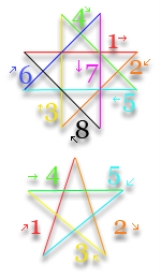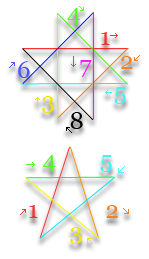
Auseklis
Encyclopedia
Auseklis was a Latvia
n god, and the personification of the celestial body Venus
. He is third most popular deity in Latvian mythology
after Saulė and Mēness, but is only mentioned in dainas and probably was invented by Krišjānis Barons
.
 Auseklis is closely associated with Mēness ("moon"). They both are Dieva dēli ("sons of God"), and are thus confused with each other and with other male deities. Auseklis is the groom of Saules meita ("daughter of the sun", Lithuanian Aušrinė
Auseklis is closely associated with Mēness ("moon"). They both are Dieva dēli ("sons of God"), and are thus confused with each other and with other male deities. Auseklis is the groom of Saules meita ("daughter of the sun", Lithuanian Aušrinė
). Few dainas suggest that Auseklis probably is too young to ride a horse, so respectively a horse for him is bought. However, it is said that "a son doesn't need it yet". It isn't clear if the word "son" refers Auseklis himself, his son, or the horse.
), which became the symbol of the third Latvian National Awakening
, is named Auseklis. It is also known as a cross of Lietuvēns (an evil spirit). The other symbol is the pentagram
, which symbolizes Venus in other cultures. Thus, both signs could have been symbols of Auseklis, originally used for protection against evil spirits. Later, the pentagram became a symbol of evil spirits. Both signs had to be drawn without lifting the hand. The images to the right shows how to do it step-by-step. Auseklis as a sign is of Finno-Ugric origin and came into Latvian mythology from the native Finno-Ugric inhabitants of modern-day Latvia.
Latvia
Latvia , officially the Republic of Latvia , is a country in the Baltic region of Northern Europe. It is bordered to the north by Estonia , to the south by Lithuania , to the east by the Russian Federation , to the southeast by Belarus and shares maritime borders to the west with Sweden...
n god, and the personification of the celestial body Venus
Venus
Venus is the second planet from the Sun, orbiting it every 224.7 Earth days. The planet is named after Venus, the Roman goddess of love and beauty. After the Moon, it is the brightest natural object in the night sky, reaching an apparent magnitude of −4.6, bright enough to cast shadows...
. He is third most popular deity in Latvian mythology
Latvian mythology
Latvian culture, along with Lithuanian, is among the oldest surviving Indo-European cultures. Much of its symbolism is ancient. Its seasons, festivals, and numerous deities reflect the essential agrarian nature of Latvian tribal life...
after Saulė and Mēness, but is only mentioned in dainas and probably was invented by Krišjānis Barons
Krišjanis Barons
Krišjānis Barons is known as the "father of the dainas" thanks largely to his systematization of the Latvian folk songs and his labour in preparing their texts for publication in Latvju dainas. His portrait appears on the 100-lat banknote, the only human face of a living person on modern Latvian...
.
Auseklis as a god

Aušrine
Aušrinė is a feminine deity of the Morning Star in the Lithuanian mythology. She is the antipode to Vakarinė, the Evening Star. Her cult possibly stems from the Proto-Indo-European religion and is related to Latvian Auseklis, Greek Eos, Roman Aurora, and Vedic Ushas. Aušrinė is the goddess of...
). Few dainas suggest that Auseklis probably is too young to ride a horse, so respectively a horse for him is bought. However, it is said that "a son doesn't need it yet". It isn't clear if the word "son" refers Auseklis himself, his son, or the horse.
Auseklis as a sign
An eight-pointed star (a regular octagramOctagram
In geometry, an octagram is an eight-sided star polygon.- Geometry :In general, an octagram is any self-intersecting octagon ....
), which became the symbol of the third Latvian National Awakening
Latvian National Awakening
The Latvian National Awakening refers to three distinct but ideologically related National revival movements:* the First Awakening refers to the national revival led by the Young Latvians from the 1850s to the 1880s,...
, is named Auseklis. It is also known as a cross of Lietuvēns (an evil spirit). The other symbol is the pentagram
Pentagram
A pentagram is the shape of a five-pointed star drawn with five straight strokes...
, which symbolizes Venus in other cultures. Thus, both signs could have been symbols of Auseklis, originally used for protection against evil spirits. Later, the pentagram became a symbol of evil spirits. Both signs had to be drawn without lifting the hand. The images to the right shows how to do it step-by-step. Auseklis as a sign is of Finno-Ugric origin and came into Latvian mythology from the native Finno-Ugric inhabitants of modern-day Latvia.

